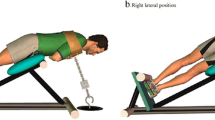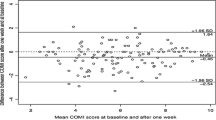Abstract
Introduction: This study was performed to study intensity and duration of symptom increase following an FCE and to explore safety of an FCE. Methods: Included were 92 patients with chronic low back pain (CLBP), mean age 38.5 years, mean self-reported disability 12.5 (Roland Morris Disability Questionnaire). All patients underwent an FCE. Symptom increase was measured with a 2-item questionnaire. Operational definition for safety: no formal complaint filed and symptom increase to occur only temporarily. Results: No formal complaints were filed (n=92). In total, 54 patients returned the questionnaire (59%; ‘responders’). Of the responders, 76% reported increased symptom intensity after an FCE, ranging from ‘little increase’ to ‘severe increase’. Symptoms of all responders returned to pre-FCE level. Duration of symptom increase of the responders ranged from 1 day to 3 weeks. Symptom increase resided to pre-FCE level within 1 week in 93% of the responders. Symptom increase was weakly related to self-reported disability (r=0.38, p<0.05). Except for gender, differences between responders and non-responders were non-significant. Conclusion: A temporary increase in symptom intensity following an FCE is common. Within the operational definitions of safety used in this study, assessment of functional capacity of patients with CLBP appears safe.
Similar content being viewed by others
Notes
Isernhagen WorkWell Systems Inc., Duluth, Minnesota, USA.
References
Hart DL, Isernhagen SJ, Matheson LN. Clinical commentary: guidelines for functional capacity evaluation of people with medical conditions. JOSPT 1993;18:682–6.
Brouwer S, Reneman MF, Dijkstra PU, Groothoff JW, Schellekens JMH, Göeken LNH. Test-retest reliability of the Isernhagen Work Systems functional capacity evaluation in patients with chronic low back pain. J Occup Rehabil 2003;13:207–18.
Reneman MF, Brouwer S, Speelman-Meinema A, Dijkstra PU, Geertzen JHB, Groothoff JW. Test-retest reliability of the Isernhagen Work Systems functional capacity evaluation in healthy adults. J Occup Rehabil 2004;14:295–305.
Reneman MF, Dijkstra PU, Westmaas M, Göeken LNH. Test-retest reliability of lifting and carrying in a 2-day functional capacity evaluation. J Occup Rehabil 2002;12:269–76.
Gross DP, Battie MC. Reliability of safe maximum lifting determinations of a functional capacity evaluation. Phys Ther 2002;82:364–71.
Reneman MF, Jorritsma W, Dijkstra SJ, Dijkstra PU. The relationship between kinesiophobia and performance in a Functional Capacity Evaluation. J Occup Rehabil 2003;13:277–85.
Reneman MF, Jorritsma W, Schellekens JMH, Göeken LNH. Concurrent validity of questionnaire and performance-based disability measurements in patients with chronic non-specific low back pain. J Occup Rehabil 2002;12:119–30.
Gross DP, Battie MC. The construct validity of a kinesiophysical functional capacity evaluation administered within a workers’ compensation environment. J Occup Rehabil 2003;13:287–95.
Smith RL. Therapists’ ability to identify safe maximum lifting in low back pain patients during functional capacity evaluation. JOSPT 1994;19:277–81.
Gardener L, McKenna K. Reliability of occupational therapists in determining safe, maximal lifting capacity. Aus Occup Ther J 1999;46:110–9.
Isernhagen SJ, Hart DL, Matheson LM. Reliability of independent observer judgements of level of lift effort in a kinesiophysical Functional Capacity Evaluation. WORK 1999;12:145–50.
Reneman MF, Jaegers SMHJ, Westmaas M, Göeken LNH. The reliability of determining effort level of lifting and carrying in a functional capacity evaluation. WORK 2002;18:23–7.
Gibson L, Strong J. Safety issues in functional capacity evaluation: findings from a trial of a new approach for evaluating clients with chronic back pain. J Occup Rehabil 2005;15:237–51.
Hart DL, Berlin S, Brager PE, Caruso M, Hejduk JF, Howar JM, Snyder KP, Susi JL, Wah MD. Development of clinical standards in industrial rehabilitation. JOSPT 1994;19:232–41.
Hoogendoorn WE, van Poppel MNM, Bongers PM, Koes BW, Bouter LM. Physical load during work and leisure time as risk factors for low back pain: a systematic review. Scand Work Environ Health 1999;25:387–403.
Hoogendoorn WE, Bongers PM, de Vet HCW, Douwes M, Koes BW, Miedema MC, Ariens GA, Bouter LM. Flexion and rotation of the trunk and lifting at work are risk factors for low back pain: results of a prospective cohort study. Spine 2000;25:3087–92.
Gross DP, Battie MC. The prognostic value of functional capacity evaluation in patients with chronic low back pain: part 1. Timely return to work. Spine 2004;14:914–9.
Matheson LN, Mooney V, Grant JE, Affleck M, Hall H, Melles T, Lichter RL, Mclntosh G. A test to measure lift capacity of physically impaired adults; Part I: development and reliability testing. Spine 1995;19:2119–29.
Kuijer W, Brouwer S, Schiphorst Preuper HR, Dijkstra PU, Groothoff JW, Geertzen JHB. Work status and chronic low back pain. Exploring the international classification of functioning, disability and health. Disabil Rehabil 2005 (in press);27.
Nachemson A, Vingard E. Assessment of patients with back and neck pain: a best-evidence synthesis. In: Nachemson A, Jonsson E, editors. Neck and back pain: the scientific evidence of causes, diagnostics, and treatment. Philadelphia: Lippincott Williams & Wilkins; 2000. pp. 57–79.
Roland M, Morris R. A study of the natural history of back pain. Part 1: development of a reliable and sensitive measure of disability in low-back pain. Spine 1983;8:141–4.
Brouwer S, Kuijer W, Dijkstra PU, Göeken LNH, Groothoff JW, Geertzen JHB. Reliability and stability of the Roland Morris Disability Questionnaire: intra class correlation and limits of agreement. Disabil Rehabil 2004;26:162–5.
van Dieen JH, Hoozemans MJ, Toussaint HM. Stoop or squat: a review of biomechanical studies on lifting technique. Clin Biomech 1999;14:685–96.
Munro BH, Visintainer MA, Batten Page E. Statistical methods for healthcare research. Philadelphia: JB Lippencott Company; 1986.
King PM, Tuckwell N, Barrett TE. A critical review of Functional Capacity Evaluations. Phys Therapy 1998;78:852–66.
Newton M, Waddell G. Trunk strength testing with iso-machines. Part 1: review of a decade of scientific evidence. Spine 1993;18:801–11.
Fordyce WE. Back pain in the workplace; management of disability in non-specific conditions. USA: IASP Press; 1995.
Powers SK, Howley ET. Exercise physiology. Theory and application to fitness and performance. 4th ed. New York: McGraw-Hill; 2001.
Coudreuse JM, Dupont P, Nicol C. Delayed post effort muscle soreness. Ann Readapt Med Phys 2004;47:290–8.
Acknowledgement
The data of this study were collected as part of the low back pain disability (LOBADIS) research program, supported by Zorgonderzoek Nederland (ZON) grant number 96-06-006. The authors wish to acknowledge the support of the physiatrists during this study.
Author information
Authors and Affiliations
Corresponding author
Rights and permissions
About this article
Cite this article
Reneman, M.F., Kuijer, W., Brouwer, S. et al. Symptom Increase Following a Functional Capacity Evaluation in Patients with Chronic Low Back Pain: An Explorative Study of Safety. J Occup Rehabil 16, 192–200 (2006). https://doi.org/10.1007/s10926-006-9023-6
Published:
Issue Date:
DOI: https://doi.org/10.1007/s10926-006-9023-6




